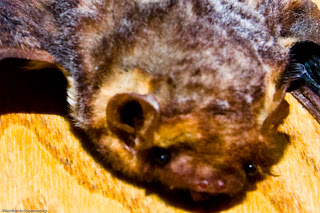I ran across a Big Brown Bat on the street last night, right at dusk. It had apparently escaped the talons of an owl, punctured in the chest by a talon. It soon died on the street after trying valiantly to recover and fly off. I feared it could have rabies, like many residents tend to do, so I ran home and got my camera and some gloves and something to carry the animal. On my return to the site, it had already died, looking more like a glob of mud on the ground than a mammal. I did retrieve the bat, placed it in a bag and took it home.
After calling agencies to find out the appropriate action I should take, it became apparent that no one of authority was concerned about rabies nor was there any advice except to bury the creature. Rabies is not as prevalent in bats as we might think. That is what makes the news, but the risk is not so much a reality. So after calling, I took a few photos and buried the creature.
The Big Brown Bat does not have prominent visible teeth like some bats. It is a very common bat species. It can number 1000 in one forest group. Here, there is no telling where its family might be, only that it should be very close-by, considering the time of day that I found it. I know of one home in this neighborhood that has a bat house attached to it. Maybe that was its habitat.
Our forests are amazing. They contain a large diversity of animals and plants.
Subscribe to:
Post Comments (Atom)




No comments:
Post a Comment